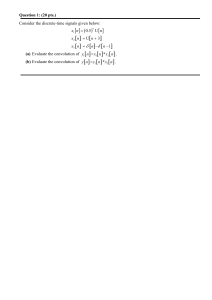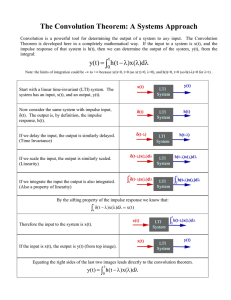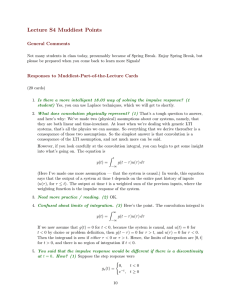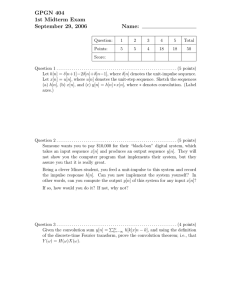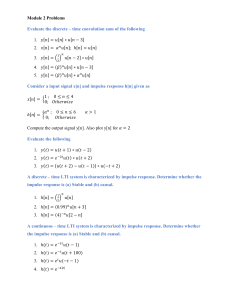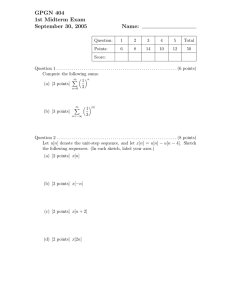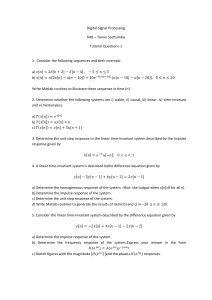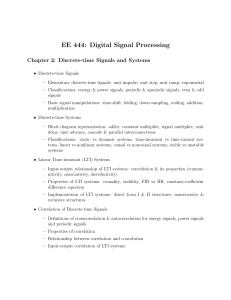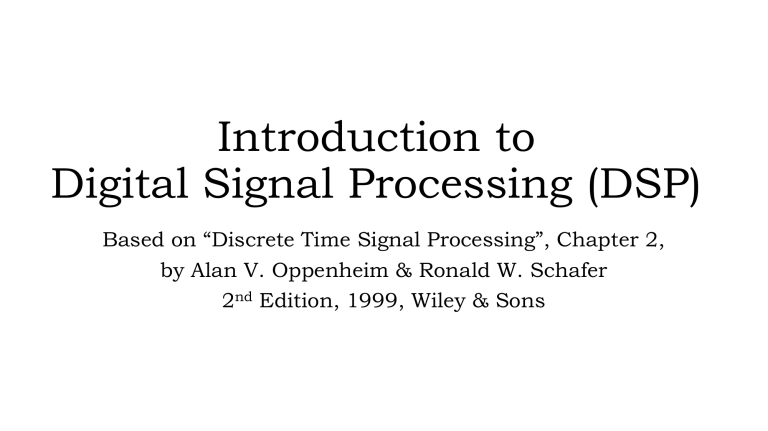
Introduction to
Digital Signal Processing (DSP)
Based on “Discrete Time Signal Processing”, Chapter 2,
by Alan V. Oppenheim & Ronald W. Schafer
2nd Edition, 1999, Wiley & Sons
Topics
Discrete-Time Signals (Sec. 2.1)
Discrete-Time Systems (Sec. 2.2)
Linear Time-Invariant Systems (Sec. 2.3~2.4)
Linear Constant Coefficient Difference Equations (Sec. 2.5)
Frequency Domain Representation of Discrete-Time
Signals and Systems (Sec. 2.6)
➢ Representation of Sequences be Fourier Transforms (Sec.
2.7~2.9)
➢
➢
➢
➢
➢
Systems
➢ Continuous-Time (CT) Systems:
System TC {•}
x(t)
y(t)
➢ Discrete-Time (DT) Systems:
System TD{•}
𝑥[𝑛]
𝑦[𝑛]
𝑦(𝑡) = 𝑇𝐶 { 𝑥(𝑡) }
x(t), y(t):
continuous-time
continuous value
𝑦[𝑛] = 𝑇𝐷 { 𝑥[𝑛] }
𝑥[𝑛], 𝑦[𝑛]:
discrete-time
continuous value
Systems
➢ Digital Systems:
✓ Digital signal processing deals with the transformation
of signals that are discrete in both amplitude and time.
𝑦[𝑛] = 𝑇𝐷 { 𝑥[𝑛] }
System TD{•}
𝑥[𝑛]
𝑦[𝑛]
𝑥[𝑛], 𝑦[𝑛]
discrete time
discrete value
(digital signal)
Example 2.3: The Ideal Delay System
The ideal delay system is defined as:
𝑦[𝑛] = 𝑇𝐷 { 𝑥[𝑛] } = 𝑥[𝑛 − 𝑛𝑑 ]
− < 𝑛 <
𝑛𝑑 : a fixed integer representing the shifting of the
input signal by the system
✓ 𝑛𝑑 > 0: the system shifts the input sequence to
the right by 𝑛𝑑 samples to form the output.
✓ 𝑛𝑑 < 0: the system shifts the input signal to the
left by |𝑛𝑑 | samples to form the output.
For simplicity, let use symbol 𝑇 for operation, instead of 𝑇𝐷 , from this
point on.
Example 2.4: Moving Average System
The general moving average system is defined as:
𝑦𝑛 =
1
2
σ𝑀
𝑥[𝑛
𝑀1 +𝑀2 +1 𝑘=−𝑀1
=
1
{𝑥
𝑀1 +𝑀2 +1
− 𝑘]
𝑛 + 𝑀1 + 𝑥 𝑛 + 𝑀1 − 1 + ⋯ + 𝑥 𝑛
+𝑥 𝑛 − 1 + ⋯ + 𝑥[𝑛 − 𝑀2 ]}
Let 𝑀2, 𝑀10
𝑦[𝑛]: the 𝑛𝑡ℎ sample of the output sequence
= the average of 𝑀 (= 𝑀1 + 𝑀2 + 1) samples of the
input sequence around the nth sample 𝑥[𝑛].
M-Point Moving Average System
Properties of Systems
➢
➢
➢
➢
➢
Linear
Time-Invariant
Causality
Stability
Memoryless Systems
These are properties of “the system”, but not of the input
signals to a system.
✓ For the system to have the property, it must hold for all
inputs, not just for some specific inputs.
Linear Systems
❖ Defined by the principle of superposition.
➢ Definition 1:
Let 𝑦1[𝑛] = 𝑇{ 𝑥1[𝑛] } and 𝑦2[𝑛] = 𝑇{ 𝑥2[𝑛] }
The system is linear if and only if the following 2
conditions are satisfied for all n:
✓ 𝑇{ 𝑥1[𝑛] + 𝑥2[𝑛] } = 𝑇{ 𝑥1[𝑛] } + 𝑇{ 𝑥2[𝑛] } = 𝑦1[𝑛] + 𝑦2[𝑛]
(the additivity property)
✓ 𝑇{ 𝑎𝑥1[𝑛] } = 𝑎 × 𝑇{ 𝑥1[𝑛] } = 𝑎𝑦1[𝑛]
𝒚𝒏
(the homogeneity or scaling property)
a: an arbitrary constant
𝒙𝒏
Linear Systems
❖ Defined by the principle of superposition.
➢ Definition 2:
Let 𝑦1[𝑛] = 𝑇{ 𝑥1[𝑛] } and 𝑦2[𝑛] = 𝑇{ 𝑥2[𝑛] }
The system is linear if and only if the following
condition is satisfied for all n:
✓ 𝑇{ 𝑎𝑥1[𝑛] + 𝑏𝑥2[𝑛] } = 𝑇{ 𝑎𝑥1[𝑛] } + 𝑇{ 𝑏𝑥2[𝑛] }
= 𝑎𝑇{ 𝑥1[𝑛] } + 𝑏𝑇{ 𝑥2[𝑛] }
= 𝑎𝑦1[𝑛] + 𝑏𝑦2[𝑛]
𝑎, 𝑏: arbitrary constants
Linear Systems
❖ The principle of superposition.
➢ Definition 2 can be generalized to:
let 𝑇 𝑥𝑘 𝑛 = 𝑦𝑘 [𝑛]
𝑥 𝑛 = σ𝑘 𝑎𝑘 𝑥𝑘 [𝑛] and 𝑦 𝑛 = σ𝑘 𝑎𝑘 𝑦𝑘 [𝑛]
𝑎𝑘: arbitrary constants
The system is linear if, for all n, it satisfies:
𝑇 𝑥 𝑛 = 𝑇 σ𝑘 𝑎𝑘 𝑥𝑘 𝑛 = σ𝑘 𝑎𝑘 𝑇 𝑥𝑘 𝑛
= σ𝑘 𝑎𝑘 𝑦𝑘 𝑛
Showing that this part holds under operation T{•}.
Example 2.3: The Ideal Delay System
The ideal delay system is a linear system.
𝑃𝑟𝑜𝑜𝑓:
𝑦1 𝑛 = 𝑇 𝑥1 𝑛 = 𝑥1 𝑛 − 𝑛𝑑 , − < 𝑛 <
𝑦2 𝑛 = 𝑇 𝑥2 𝑛 = 𝑥2 𝑛 − 𝑛𝑑 , − < 𝑛 <
(i.e., for all n)
let 𝑥3 𝑛 = 𝑎𝑥1 𝑛 + 𝑏𝑥2 𝑛 ,
𝑎, 𝑏: arbitrary constant
𝑦3 𝑛 = 𝑇 𝑥3 𝑛 = 𝑇{𝑎𝑥1 𝑛 + 𝑏𝑥2 𝑛 }
= 𝑥3 𝑛 − 𝑛𝑑
= 𝑎𝑥1 [𝑛 − 𝑛𝑑 ] + 𝑏𝑥2 [𝑛 − 𝑛𝑑 ]
= 𝑎𝑦1 𝑛 + 𝑏𝑦2 𝑛 = 𝑎𝑇{𝑥1 𝑛 } + 𝑏𝑇{𝑥2 𝑛 }
The relation 𝑇{𝑎𝑥1 𝑛 + 𝑏𝑥2 𝑛 } = 𝑎𝑦1 𝑛 + 𝑏𝑦2 𝑛 is satisfied,
the ideal delay system is a linear system.
Example 2.6: Accumulator System
The accumulator system is defined as:
𝑦 𝑛 = σ𝒏𝑘=−∞ 𝑥[𝑘]
The output 𝑦[𝑛] at time 𝑛 is the accumulation or sum of
the present and all previous input samples 𝑥[𝑘].
✓ A system with memory. (obviously)
✓ Linear system.
𝑃𝑟𝑜𝑜𝑓: (for showing that the system is a linear system)
Let 𝑦1 𝑛 = σ𝒏𝑘=−∞ 𝑥1 [𝑘] and 𝑦2 𝑛 = σ𝒏𝑘=−∞ 𝑥2 [𝑘]
𝑥3 𝑛 = 𝑎𝑥1 𝑛 + 𝑏𝑥2 [𝑛],
𝑎, 𝑏: arbitrary constants
Example 2.6-Accumulator System (contd.)
Need to show that 𝑦3 𝑛 = 𝑎𝑦1 𝑛 + 𝑏𝑦2 𝑛
𝑦3 𝑛 = σ𝑛𝑘=−∞ 𝑥3 𝑘 = σ𝑛𝑘=−∞(𝑎𝑥1 𝑘 + 𝑏𝑥2 𝑘 )
= σ𝑛𝑘=−∞ 𝑎𝑥1 𝑘 + σ𝑛𝑘=−∞ 𝑏𝑥2 𝑘
= 𝑎 σ𝑛𝑘=−∞ 𝑥1 𝑘 + 𝑏 σ𝑛𝑘=−∞ 𝑏𝑥2 𝑘
= 𝑎𝑦1 𝑛 + 𝑏𝑦2 𝑛
The accumulator system above satisfies the superposition
principle for all inputs and is therefore linear.
Example 2.7: A Non-linear System
A system defined as:
𝑦 𝑛 = 𝑇{𝑥 𝑛 } = 𝑥 𝑛
𝑃𝑟𝑜𝑜𝑓:
2
➔ The system is NOT linear.
✓ to show that a system is linear, must show that the system
satisfies the relation below for all n.
𝑇 𝑥 𝑛 = 𝑇 σ𝑘 𝑎𝑘 𝑥𝑘 𝑛 = σ𝑘 𝑎𝑘 𝑇 𝑥𝑘 𝑛 = σ𝑘 𝑎𝑘 𝑦𝑘 𝑛
✓ to disprove that a system is linear ➔ one counter-example is
enough. (because the condition “for all n” is not met.)
Let 𝑦𝑘 𝑛 = 𝑇 𝑥𝑘 𝑛 , 𝑘 = 1, 2, and 𝑥3 𝑛 = 𝑥1 𝑛 + 𝑥2 𝑛
𝑦3 𝑛 = 𝑇 𝑥3 𝑛 = 𝑥1 𝑛 + 𝑥2 𝑛 2
≠ 𝑇 𝑥1 𝑛 + 𝑇 𝑥2 𝑛
= 𝑥1 𝑛
2
+ 𝑥2 𝑛
2
Example 2.8: A Non-linear System
A system defined as:
𝑦 𝑛 = log10 ( 𝑥 𝑛 ) ➔ The system is NOT linear.
𝑃𝑟𝑜𝑜𝑓:
Let 𝑥1 𝑛 = 1, 𝑥2 𝑛 = 10, and 𝑥3 𝑛 = 𝑥1 𝑛 + 𝑥2 𝑛
𝑦1 𝑛 = 𝑇 𝑥1 𝑛 = 1𝑜𝑔10 1 = 0
𝑦2 𝑛 = 𝑇 𝑥2 𝑛 = 1𝑜𝑔10 10 = 1
𝑦3 𝑛 = 𝑇 𝑥3 𝑛 = 1𝑜𝑔10 11 ≅ 1.041
≠ 𝑇 𝑥1 𝑛 + 𝑇 𝑥2 𝑛 = 1
to disprove that a system is linear
➔ one counter-example is enough.
Time-Invariant Systems
❖ Definition:
For a time-invariant system, a time shift or delay of the
input sequence causes a corresponding shift in the
output sequence.
let 𝑦 𝑛 = 𝑇 𝑥 𝑛
for all 𝑛
𝑥1 𝑛 = 𝑥 𝑛 − 𝑛0 , 𝑛0 : arbitrary integer
if 𝑇 𝑥1 𝑛
= 𝑇 𝑥 𝑛 − 𝑛0
to disprove that a system is time= 𝑦 𝑛 − 𝑛0
invariant
➔ one counter-example is enough.
= 𝑦1 𝑛
then, the system is time-invariant.
Time-Invariant Systems
𝑥[𝑛]
𝑦[𝑛]
system
system
𝑥[𝑛]
Time
shifting
𝑦[𝑛]
𝑇{ 𝑥[𝑛] }
𝑥[𝑛 − 𝑛0]
𝑇{ 𝑥[𝑛] } = 𝑦[𝑛]
Time
shifting
system
𝑦[𝑛 − 𝑛0]
?
𝑇{ 𝑥[𝑛 − 𝑛0] }
Example: Time-invariant System
Considering the moving-average (MA) system defined as:
𝑦1 𝑛 = 𝑇 𝑥1 𝑛
=
1
2
σ𝑀
𝑥 [𝑛
𝑀1 +𝑀2 +1 𝑘=−𝑀1 1
− 𝑘] ,
𝑀2, 𝑀10
Let 𝑥2 𝑛 = 𝑥1 𝑛 − 𝑛0 , 𝑛0 : an arbitrary constant
𝑦2 𝑛 = 𝑇 𝑥2 𝑛 = 𝑇 𝑥1 𝑛 − 𝑛0
The MA system is
time-invariant
=
=
1
2
σ𝑀
𝑥
[𝑛
2
𝑘=−𝑀
1
𝑀1 +𝑀2 +1
1
2
σ𝑀
𝑥 [𝑛
𝑀1 +𝑀2 +1 𝑘=−𝑀1 1
− 𝑘]
− 𝑛0 − 𝑘]
= 𝑦1 𝑛 − 𝑛0
Examples 2.2 ~ 2.6 discussed previously are all “Time-invariant” systems.
Examine ONLY the moving-average system as example here.
Example 2.8-Accumulator System
Considering the accumulator system defined as:
𝑦1 𝑛 = σ𝒏𝑘=−∞ 𝑥1[𝑘]
To find out if the accumulator system is time-invariant :
let 𝑥2 𝑛 = 𝑥1 𝑛 − 𝑛0 , 𝑛0 : an arbitrary constant
𝑦2 𝑛 = 𝑇 𝑥2 𝑛 = 𝑇 𝑥1 𝑛 − 𝑛0
= σ𝑛𝑘=−∞ 𝑥2 𝑘 = σ𝑛𝑘=−∞ 𝑥1 𝑘 − 𝑛0
let = 𝑘 − 𝑛0
σ𝑛𝑘=−∞ 𝑥1 𝑘 − 𝑛0
𝑘 = −∞ → = −
𝑘 = 𝑛 → = 𝑛 − 𝑛0
0 𝑥
= σ𝑛−𝑛
=−∞ 1 = 𝑦1 𝑛 − 𝑛0
➔
The accumulator system is time-invariant.
Example 2.9-The Compressor System
The compressor system is defined as:
𝑦[𝑛] = 𝑇{𝑥[𝑛]} = 𝑥[𝑀𝑛],
− < 𝑛 < ,
𝑀∈𝑁
The system keeps 1 sample and discards the rest (𝑀 − 1)
samples for every 𝑀 samples.
let 𝑥2 𝑛 = 𝑥1 𝑛 − 𝑛0 , 𝑛0 : an arbitrary integer
𝑦1 𝑛 = 𝑇 𝑥1 𝑛 = 𝑥1 𝑀𝑛
𝑦2 𝑛 = 𝑇 𝑥2 𝑛 = 𝑥2 𝑀𝑛 = 𝑥1 𝑀𝑛 − 𝑛0
= 𝑇 𝑥1 𝑛 − 𝑛0
It can also be shown
that a system is NOT
time-invariant by
finding a single
counter-example that
violates the timeinvariance property.
𝑦1 𝑛 − 𝑛0 = 𝑥1 𝑀 𝑛 − 𝑛0
𝑇 𝑥 𝑛 − 𝑛0
≠ 𝑦 𝑛 − 𝑛0 , the system is NOT time-invariant.
Example
Let
𝑀 = 2 ➔ 𝑦[𝑛] = 𝑇{ 𝑥[𝑛] } = 𝑥[𝑀𝑛] = 𝑥[2𝑛]
Shifting by 𝑛0 = 2
𝑥[𝑛]
𝑦[𝑛] = 𝑥[2𝑛]
𝑥[𝑛 − 𝑛0 ], 𝑛0 = 2
𝑇 𝑥𝑛
3
3
2
2
1
1
-1
0
1
2
3
4
5
6
7
8
n
-1
0
3
3
2
2
1
1
0
1
2
3
4
2
3
4
5
6
n
𝑦[𝑛 − 𝑛0 ]
𝑇{ 𝑥[𝑛 − 𝑛0 ] }
-1
1
=𝑦 𝑛
5
6
n
-1
0
1
2
3
4
5
6
n
Exercises
Determine whether or not each of the following systems is
time-invariant:
a) 𝑦[𝑛] = 𝑥[𝑛] + 𝑥[𝑛 − 1] + 𝑥[𝑛 − 2]
b) 𝑦[𝑛] = 𝑥[𝑛]𝑢[𝑛]
c) 𝑦[𝑛] = σ𝑛𝑘=−∞ 𝑥[𝑘]
d) 𝑦[𝑛] = 𝑥[𝑛2]
e) 𝑦[𝑛] = 𝑥[−𝑛]
Problem 1.14, “Schaum’s outline: Digital Signal Processing”, 1st, McGraw Hill, 1999
Causality
❖ Definition:
For every choice of 𝑛0 , the output sequence value at the
index 𝑛 = 𝑛0 depends only on the input sequence values
for index 𝑛 ≤ 𝑛0 . (i.e., do NOT depend on the future.)
❖ For a causal system:
✓ if 𝑥1 𝑛 = 𝑥2 𝑛 for 𝑛 ≤ 𝑛0 , then 𝑦1 𝑛 = 𝑦2 𝑛 for 𝑛 ≤ 𝑛0 .
the system is non-anticipative.
𝑦 𝑛 = 𝑓 𝑥 𝑛 ,𝑥 𝑛 − 1 ,𝑥 𝑛 − 2 ,…
Example 2.10-Forward/Backward
Difference Systems
➢ The forward difference system is defined by:
𝑦[𝑛] = 𝑥[𝑛 + 1] − 𝑥[𝑛]
✓ The system is NOT causal.
The output 𝑦[𝑛] depends on a future value of the input
𝑥[𝑛 + 1].
➢ The backward difference system is defined by:
𝑦[𝑛] = 𝑥[𝑛] − 𝑥[𝑛 − 1]
✓ The system is causal.
The output depends only on the present and the past
values of the input.
Stability
❖ “Bounded-in-Bounded-out” (B.I.B.O.) Stability:
every bounded input sequence 𝑥[𝑛] produces a bounded
output sequence 𝑦[𝑛].
✓ The input 𝑥[𝑛] is bounded if there exists a fixed positive
finite value 𝐵𝑥 such that
𝑥 𝑛 ≤ 𝐵𝑥 < ∞ for all 𝑛
✓ For every bounded input, there exists a fixed positive
finite value 𝐵𝑦 such that
𝑦 𝑛 ≤ 𝐵𝑦 < ∞ for all 𝑛
For all bounded inputs, the output is bounded.
(A counter-example disproves the statement.)
Example 2.11: Stable Systems
➢ The system (example 2.5) defined as
𝑦𝑛 = 𝑥𝑛 2
✓ The system is BIBO stable
If the input signal is bounded: 𝑥 𝑛 ≤ 𝐵𝑥 < ∞
Choose 𝐵𝑦 = 𝐵𝑥2
➔ 𝑦 𝑛 ≤ 𝐵𝑥2 = 𝐵𝑦 < ∞ for all n
(𝐵𝑥 : a fixed finite positive constant)
for all 𝑛
Example: Unstable System
➢ The accumulator (example 2.6) defined as:
𝑦 𝑛 = σnk=−∞ 𝑥 𝑘
Consider 𝑥 𝑛 = 𝑢 𝑛 (B.I. with 𝐵𝑥 = 1)
The output
0,
n<0
n
𝑦 𝑛 = σk=−∞ 𝑢 𝑘 = ቊ
n + 1, n ≥ 0
There is no fixed finite choice for 𝐵𝑦 such that
𝑛 + 1 ≤ 𝐵𝑦 < ∞ for all n
The system is unstable.
Example: Unstable System
➢ The system (example 2.7) defined as:
𝑦 𝑛 = 𝑙𝑜𝑔10 𝑥 𝑛
✓ The system is BIBO unstable:
𝑦 𝑛 = 𝑙𝑜𝑔10 0 = −∞
for any value of index 𝑛 where 𝑥 𝑛 = 0 (B.I.).
Even though the output will be bounded for input
𝑥 𝑛 ≠ 0 at other instant 𝑛.
Exercises
Determine whether or not each of the following systems is:
(a) causal, and (b) stable:
1) 𝑦[𝑛] = 𝑥[𝑛] + 𝑥[𝑛 − 1] + 𝑥[𝑛 − 2]
2) 𝑦[𝑛] = 𝑥[𝑛]𝑢[𝑛]
3) 𝑦[𝑛] = σ𝑛𝑘=−∞ 𝑥[𝑘]
4) 𝑦 𝑛 = 𝑥 𝑛2
5) 𝑦[𝑛] = 𝑥[−𝑛]
Memoryless Systems
➢ Definition:
𝑦 𝑛 = 𝑇𝐷 𝑥 𝑛
or, 𝑦[𝑛] = 𝑓(𝑥[𝑛])
for all 𝑛
At every value of 𝑛, the output 𝑦 𝑛 depends only on the
input 𝑥 𝑛 at the same value of 𝑛.
✓ Example: Memoryless System
𝑦 𝑛 = 𝑇𝐷 𝑥 𝑛
= 𝑥𝑛
2
for each value of 𝑛
At every value of 𝑛, the output 𝑦 𝑛 depends only on the
input 𝑥 𝑛 at the same value of 𝑛.
For the purpose of simplicity, symbol 𝑇 ∎ , rather than 𝑇𝐷 ∎ , will be
used to represent the “discrete-time system” from now on.
Example 2.3: Moving-Average System
➢ Example: System with/without memory
𝑦𝑛 =
1
2
σ𝑀
𝑥[𝑛
𝑀1 +𝑀2 +1 𝑘=−𝑀1
− 𝑘]
for all 𝑛
𝑀1 , 𝑀2 ≥ 0
The moving average system is:
✓ system without memory if 𝑀1 = 0, and 𝑀2 = 0.
✓ System with memory if 𝑀1 ≠ 0 or 𝑀2 ≠ 0.
Topics
Discrete-Time Signals (Sec. 2.1)
Discrete-Time Systems (Sec. 2.2)
Linear Time-Invariant Systems (Sec. 2.3~2.4)
Linear Constant Coefficient Difference Equations (Sec.
2.5)
➢ Frequency Domain Representation of Discrete-Time
Signals and Systems (Sec. 2.6)
➢ Representation of Sequences be Fourier Transforms (Sec.
2.7~2.9)
➢
➢
➢
➢
Linear Time-invariant Systems
Linear Time-invariant (LTI) Systems with properties:
a) Linearity:
𝑇 𝑎𝑥1 𝑛 + 𝑏𝑥2 𝑛 = 𝑎𝑇 𝑥1 𝑛 + 𝑏𝑇 𝑥2 𝑛
for all 𝑛
b) Time-invariant:
𝑦 𝑛 = 𝑇 𝑥 𝑛 for all 𝑛, then
𝑇 𝑥 𝑛 − 𝑛0 = 𝑦 𝑛 − 𝑛0 , 𝑛0 : an arbitrary constant
Linear Time-invariant Systems (contd.)
Considering that a general sequence can be represented as a
linear combination of delayed (or shifted) impulses.
𝑥 𝑛 = σ∞
𝑘=−∞ 𝑥 𝑘 𝛿[𝑛 − 𝑘]
With input signal 𝑥 𝑛 , the output from the LTI system:
𝑦 𝑛 =𝑇 𝑥 𝑛
Linearity
∞
σ
= 𝑇 σ∞
𝑥
𝑘
𝛿[𝑛
−
𝑘]
=
𝑘=−∞
𝑘=−∞ 𝑥 𝑘 𝑇{𝛿 𝑛 − 𝑘 }
= σ∞
𝑘=−∞ 𝑥 𝑘 ℎ𝑘 [𝑛]
for all n
The system response 𝑦 𝑛 to any input 𝑥 𝑛
= the linear combination of the system response to shifted impulses [𝑛 − 𝑘]
Linear Time-invariant Systems (contd.)
➢ Without the “time-invariant” property, only know:
ℎ𝑘 𝑛 = 𝑇 𝛿 𝑛 − 𝑘 depends on 𝑛 and 𝑘. (not really useful)
➢ With the “time-invariant” property,
ℎ𝑘 𝑛 = 𝑇 𝛿 𝑛 − 𝑘 = ℎ 𝑛 − 𝑘
Time invariant
∞
σ
𝑦 𝑛 = σ∞
𝑥
𝑘
ℎ
𝑛
=
𝑘
k=−∞
k=−∞ 𝑥 𝑘 ℎ 𝑛 − 𝑘
for all n
= 𝑥 𝑛 ∗ ℎ 𝑛 (the convolution sum)
An LTI system is completely characterized by its impulse
response ℎ 𝑛 : given the sequences 𝑥 𝑛 and ℎ 𝑛 for all 𝑛,
each sample of the output sequence 𝑦 𝑛 can be found from
the convolution sum.
The Convolution Sum
➢ The convolution sum for 2 discrete sequences 𝑥 𝑛 and
ℎ𝑛:
𝑦 𝑛 = σ∞
for all 𝑛
𝑘=−∞ 𝑥 𝑘 ℎ[𝑛 − 𝑘] = 𝑥 𝑛 ∗ ℎ 𝑛
𝑦 𝑛 − 𝑛0 = σ∞
𝑘=−∞ 𝑥 𝑘 ℎ[(𝑛 − 𝑛0) − 𝑘] = 𝑥 𝑛 ∗ ℎ 𝑛 − 𝑛0
Operator “ ∗ ”: “convolution”, not “multiplication”
𝑇 𝛿𝑛
= ℎ 𝑛 : the impulse response of a system.
𝑇 𝛿 𝑛 − 𝑛0
= ℎ 𝑛 − 𝑛0 : the shifted impulse response of a
time-invariant system.
The Convolution Sum-1st view-angle
➢ Considering every single -function in the input signal:
1. Transform the input sample at instant 𝑘 (one at a time)
into an output sequence for every 𝑘 (refer to the
example):
𝑇 𝑥 𝑘 𝛿 𝑛−𝑘
=𝑥 𝑘 𝑇 𝛿 𝑛−𝑘
=𝑥 𝑘 ℎ 𝑛−𝑘
2. For each 𝑘, the output sequences are summed to form
the gross output sequence.
𝑦 𝑛 = σ∞
𝑘=−∞ 𝑥 𝑘 ℎ[𝑛 − 𝑘]
➢ Useful identity:
𝛿 𝑛 − 𝑛 0 ∗ ℎ 𝑛 = ℎ 𝑛 − 𝑛0
Computing the output
sequence as a whole.
Example: The Convolution Sum
the individual output due to
each input sample 𝑥 𝑘
Example: The Convolution Sum (contd.)
the individual
output due to each
input sample
Computing the output sequence as a whole.
The Convolution Sum-2nd view-angle
➢ The convolution sum as for computing a single value of
the output sequence:
✓ For each value 𝑛, to find the output 𝑦 𝑛 : :
1. Compute 𝑥 𝑘 ℎ 𝑛 − 𝑘 , − < 𝑘 <
2. With 𝑘 as a counting index in the summation
process, summing all the values of the product
𝑥 𝑛 ℎ 𝑛−𝑘 .
❖ KEY: understanding how to form the sequence
ℎ 𝑛 − 𝑘 , −∞ < 𝑘 < ∞
for all values of 𝑛 interested.
Computation of ℎ[𝑛 − 𝑘]
Known ℎ 𝑘 , how to find ℎ 𝑛 − 𝑘 graphically?
Steps to find ℎ 𝑛 − 𝑘 = ℎ − 𝑘 − 𝑛
1. Define ℎ1 𝑘 = ℎ −𝑘
2. Define ℎ2 𝑘 = ℎ1 𝑘 − 𝑛
=ℎ − 𝑘−𝑛
(b)
=ℎ 𝑛−𝑘
(a)
(c)
Fig.2.9 Forming the sequence ℎ 𝑛 − 𝑘 .
(a) The sequence ℎ 𝑘 as a function of 𝑘. (b) The sequence ℎ −𝑘 as a function of 𝑘. (c)
The sequence ℎ 𝑛 − 𝑘 = ℎ − 𝑘 − 𝑛 as a function of 𝑘 for 𝑛 = 4.
Example 2.13: Evaluation of the
Convolution Sum
The system impulse response:
1,
0≤𝑛 ≤𝑁−1
ℎ 𝑛 =𝑢 𝑛 −𝑢 𝑛−𝑁 =ቊ
0,
𝑜𝑡ℎ𝑒𝑟𝑤𝑖𝑠𝑒
The input signal:
𝑛,
𝑎
𝑛≥0
0<a<1
𝑛
𝑥 𝑛 =𝑎 𝑢 𝑛 =ቊ
0,
𝑛<0
(0𝑁 − 1)
To find the output 𝑦 𝑛 = 𝑥 𝑛 ∗ ℎ 𝑛 = σ∞
𝑘=−∞ 𝑥 𝑘 ℎ 𝑛 − 𝑘
1. Graphically
2. Analytically
express ℎ 𝑛 − 𝑘 in analytical form
Example 2.13: Graphically
Only non-zero terms are shown here.
y 𝑛 = σ∞
𝑘=−∞ 𝑥 𝑘 ℎ 𝑛 − 𝑘
𝑥 𝑘 ℎ 𝑛 − 𝑘 = 0, for 𝑛 < 0
➔𝑦 𝑛 =0
𝑛 ≥ 0 and 𝑛 − 𝑁 + 1 ≤ 0
➔ 0≤𝑛 ≤ 𝑁−1
𝑥 𝑘 ℎ 𝑛 − 𝑘 = 𝑎𝑘 , 0 ≤ 𝑘 ≤ 𝑛
𝑦 𝑛 = σnk=0 ak , 0 ≤ 𝑛 ≤ 𝑁 − 1
The sequences 𝑥 𝑘 and ℎ 𝑛 − 𝑘 as a function of 𝑘 for different values of 𝑛.
Example 2.13: Graphically
0 < 𝑛 − 𝑁 − 1 , or 𝑁 − 1 < 𝑛
𝑥 𝑘 ℎ 𝑛 − 𝑘 = 𝑎𝑘 , 0 < 𝑛 − 𝑁 + 1 ≤ 𝑘 ≤ 𝑛
𝑦 𝑛 = σnk=𝑛−𝑁+1 ak , 𝑁 − 1 < 𝑛
(d) Corresponding output sequence as a function of n.
Example 2.13-Analytically
𝑛, 𝑛 ≥ 0
𝑎
𝑥 𝑛 = 𝑎𝑛 𝑢 𝑛 = ቊ
,
0<𝑎<1
0, 𝑛 < 0
1, 0 ≤ 𝑛 < 𝑁 − 1
ℎ 𝑛 =𝑢 𝑛 −𝑢 𝑛−𝑁 =൜
, 0≤ 𝑁−1
0, 𝑜𝑡ℎ𝑒𝑟𝑤𝑖𝑠𝑒
𝑦 𝑛 =𝑥 𝑛 ∗ℎ 𝑛
= σ∞
𝑘=−∞ 𝑥 𝑘 ℎ 𝑛 − 𝑘
𝑘𝑢 𝑘 (𝑢 𝑛 − 𝑘 − 𝑢 𝑛 − 𝑘 − 𝑁 )
= σ∞
𝑎
𝑘=−∞
For 𝑢 𝑘 to be “non-zero”
➔
𝑘≥0
➔
σ∞
𝑘=0 ⋯
𝑦 𝑛 =𝑥 𝑛 ∗ℎ 𝑛
𝑘 (𝑢 𝑛 − 𝑘 − 𝑢 𝑛 − 𝑘 − 𝑁 )
= σ∞
𝑎
𝑘=0
(1) 𝑛 < 0: 𝑢 𝑛 − 𝑘 = 𝑢 𝑛 − 𝑘 − 𝑁 = 0, for any 𝑘 ≥ 0
𝑦 𝑛 =0
(2) For cases of 𝑛 ≥ 0, consider 𝑛 = 0, (this is the simplest
term which results in non-zero terms for 𝑢 𝑛 − 𝑘 −
𝑢 𝑛 − 𝑘 − 𝑁 = 1.) (Just want to have non-zero term.)
Two scenarios: (a) 𝑛 ≥ 0 and 𝑛 − 𝑁 < 0; and
(b) 𝑛 ≥ 0 and 𝑛 − 𝑁 ≥ 0.
(a) 𝑛 ≥ 0 and 𝑛 − 𝑁 < 0 (𝑛 ≤ 𝑁 − 1 ).
For 𝑘 = 0, 𝑢 𝑛 − 𝑢 𝑛 − 𝑁 = 1 ➔ 𝑛 ≥ 0 and 𝑛 − 𝑁 < 0
➔ 0≤𝑛 ≤ 𝑁−1
𝑦 𝑛 = σ𝑛𝑘=0 𝑎𝑘 =
1−𝑎𝑛+1
1−𝑎
(b) 𝑛 ≥ 0 and 𝑛 − 𝑁 ≥ 0.
𝑦𝑛 =
σ𝑛𝑘=𝑛−𝑁+1 𝑎𝑘
=
𝑎𝑛−𝑁+1 −𝑎𝑛+1
1−𝑎
=
𝑁
𝑛−𝑁+1 1−𝑎
𝑎
1−𝑎
Exercise: Discrete-time Convolution
The system impulse response ℎ 𝑛 of a discrete-time LTI
system and an input signal 𝑥 𝑛 are as shown below. Find
the analytical expression of the output signal 𝑦 𝑛 from the
LTI system without using the convolution technique.
Problem 2.34, “Schaum’s-Signals and Systems”, 2nd, McGraw Hill, 2011
Exercise: Discrete-time Convolution
1.
2.
3.
4.
𝑥 𝑛 ∗𝛿 𝑛
𝑥 𝑛 ∗ 𝛿 𝑛 − 𝑛0
𝑥 𝑛 ∗𝑢 𝑛
𝑥 𝑛 ∗ 𝑢 𝑛 − 𝑛0
5. Evaluate 𝑦 𝑛 = 𝑥 𝑛 ∗ ℎ 𝑛 (a) analytically, and (b)
graphically
Problem 2.27, 2.30, “Schaum’s-Signals and Systems”, 2nd, McGraw Hill, 2011
LTI Systems
All LTI systems are described by the convolution sum:
𝑦 𝑛 = 𝑥 𝑛 ∗ ℎ 𝑛 = σ∞
𝑘=−∞ 𝑥 𝑘 ℎ[𝑛 − 𝑘]
➔ the impulse response ℎ 𝑛 is a complete
characterization of the properties of a specific LTI
system.
• 𝑥 𝑛 : the input signal.
• ℎ 𝑛 : the impulse response of the system.
Definition: ℎ 𝑛 = 𝑇 𝛿 𝑛
• 𝑦 𝑛 : the output signal.
Properties of Convolution Operation
➢ Commutative:
𝑥 𝑛 ∗ℎ 𝑛 =ℎ 𝑛 ∗𝑥 𝑛
➢ Distributes over addition:
𝑥 𝑛 ∗ ℎ1 𝑛 + ℎ2 𝑛 = 𝑥 𝑛 ∗ ℎ1 𝑛 + 𝑥 𝑛 ∗ ℎ2 𝑛
➢ Associative:
𝑥 𝑛 ∗ ℎ1 𝑛 ∗ ℎ2 𝑛 = 𝑥 𝑛 ∗ ℎ1 𝑛 ∗ ℎ2 𝑛
= 𝑥 𝑛 ∗ ℎ2 𝑛 ∗ ℎ1 𝑛
= 𝑥 𝑛 ∗ ℎ2 𝑛 ∗ ℎ1 𝑛
Properties of convolution operation are inherently properties of LTI
systems.
Commutative
Show: 𝑥 𝑛 ∗ ℎ 𝑛 = ℎ 𝑛 ∗ 𝑥 𝑛
𝑦 𝑛 =𝑥 𝑛 ∗ℎ 𝑛
= σ∞
𝑘=−∞ 𝑥 𝑘 ℎ[𝑛 − 𝑘]
= σ−∞
𝒎=∞ 𝑥 𝑛 − 𝑚 ℎ[𝑚]
Let 𝑚 = 𝑛 − 𝑘 ➔ 𝑘 = 𝑛 − 𝑚
𝑘 = −∞
𝑚=∞
𝑘=∞
𝑚 = −∞
= σ∞
𝒎=−∞ 𝑥 𝑛 − 𝑚 ℎ[𝑚] = ℎ 𝑛 ∗ 𝑥[𝑛]
the system output is the same if the roles of the input and impulse
response are reversed.
Distributes over addition
𝑥 𝑛 ∗ ℎ1 𝑛 + ℎ2 𝑛
= 𝑥 𝑛 ∗ ℎ1 𝑛 + 𝑥 𝑛 ∗ ℎ2 𝑛 = 𝑥 𝑛 ∗ ℎ𝑡𝑜𝑡𝑎𝑙 𝑛
ℎ𝑡𝑜𝑡𝑎𝑙 𝑛 = ℎ1 𝑛 + ℎ2 𝑛 = ℎ2 𝑛 + ℎ1 𝑛
Figure 2.11 (a) Parallel combination of LTI systems.
(b) An equivalent system.__
Associative
𝑥 𝑛 ∗ ℎ1 𝑛
∗ ℎ2 𝑛 = 𝑥 𝑛 ∗ ℎ1 𝑛 ∗ ℎ2 𝑛
= 𝑥 𝑛 ∗ ℎ2 𝑛 ∗ ℎ1 𝑛
= 𝑥 𝑛 ∗ ℎ2 𝑛 ∗ ℎ1 𝑛 = 𝑥 𝑛 ∗ ℎ𝑡𝑜𝑡𝑎𝑙 𝑛
ℎ𝑡𝑜𝑡𝑎𝑙 𝑛 = ℎ1 𝑛 ∗ ℎ2 𝑛 = ℎ2 𝑛 ∗ ℎ1 𝑛
(commutative)
Figure 2.12 (a) Cascade combination of 2 LTI systems. (b) Equivalent
cascade. (c) Single equivalent system.
Example: The impulse response ℎ 𝑛
Determination of the impulse response ℎ 𝑛 of the following
systems:
(a) Ideal delay system 𝑦 𝑛 = 𝑇 𝑥 𝑛 = 𝑥 𝑛 − 𝑛𝑑 .
(b) Moving average system 𝑦 𝑛 =
1
2
σ𝑀
𝑥[𝑛
𝑘=−𝑀
1
𝑀1 +𝑀2 +1
(c) Accumulator system 𝑦 𝑛 = σ𝑛𝑘=−∞ 𝑥[𝑘]
(d) Forward difference system 𝑦 𝑛 = 𝑥 𝑛 + 1 − 𝑥 𝑛
(e) Backward difference system 𝑦 𝑛 = 𝑥 𝑛 − 𝑥 𝑛 − 1
− 𝑘]
Solution:
The impulse response ℎ 𝑛 = 𝑇 𝛿 𝑛 :
a) Ideal delay system 𝑦 𝑛 = 𝑇 𝑥 𝑛 = 𝑥 𝑛 − 𝑛𝑑 .
ℎ 𝑛 = 𝑇 𝛿 𝑛 = 𝛿 𝑛 − 𝑛𝑑 , 𝑛𝑑 : a positive fixed integer.
b) Moving average system 𝑦 𝑛 =
ℎ𝑛 =
1
2
σ𝑀
[𝑛
𝑀1 +𝑀2 +1 𝑘=−𝑀1
1
2
σ𝑀
𝑥[𝑛
𝑀1 +𝑀2 +1 𝑘=−𝑀1
− 𝑘] =
− 𝑘]
1
, −𝑀1𝑛𝑀2
ቐ𝑀1 +𝑀2+1
0
c) Accumulator system 𝑦 𝑛 = σ𝑛𝑘=−∞ 𝑥[𝑘]
0, 𝑛 < 0
𝑛
ℎ 𝑛 = σ𝑘=−∞ 𝑘 = ቊ
= 𝑢[𝑛]
1, 𝑛 ≥ 0
, 𝑜𝑡ℎ𝑒𝑟𝑤𝑖𝑠𝑒
Solution:
The impulse response ℎ 𝑛 = 𝑇 𝛿 𝑛 : (i.e., 𝑥 𝑛 = 𝛿 𝑛 )
d) Forward difference system 𝑦 𝑛 = 𝑥 𝑛 + 1 − 𝑥 𝑛
ℎ 𝑛 =𝛿 𝑛+1 −𝛿 𝑛
e) Backward difference system 𝑦 𝑛 = 𝑥 𝑛 − 𝑥 𝑛 − 1
ℎ 𝑛 =𝛿 𝑛 −𝛿 𝑛−1
Example:
Consider the inter-connection of 4 LTI systems. The impulse
responses of the systems are:
ℎ1 𝑛 = 𝑢 𝑛 ,
ℎ2 𝑛 = 𝑢 𝑛 + 2 − 𝑢 𝑛 ,
ℎ3 𝑛 = 𝛿 𝑛 − 2 ,
ℎ4 𝑛 = 𝛼 𝑛 𝑢 𝑛
Find the impulse response h[n]
of the overall system.
Solution:
Distributes over addition:
𝑥 𝑛 ∗ ℎ1 𝑛 + 𝑥 𝑛 ∗ ℎ2 𝑛 = 𝑥 𝑛 ∗ ℎ1 𝑛 + ℎ2 𝑛
Solution:
Associative:
𝑥 𝑛 ∗ ℎ12 𝑛
∗ ℎ3 𝑛 = 𝑥 𝑛 ∗ ℎ12 𝑛 ∗ ℎ3 𝑛
= 𝑥 𝑛 ∗ ℎ3 𝑛 ∗ ℎ12 𝑛
= 𝑥 𝑛 ∗ ℎ3 𝑛 ∗ ℎ12 𝑛
Solution:
Distributes over addition:
𝑥 𝑛 ∗ ℎ1 𝑛 + 𝑥 𝑛 ∗ ℎ2 𝑛 = 𝑥 𝑛 ∗ ℎ1 𝑛 + ℎ2 𝑛
ℎ 𝑛 = ℎ123 𝑛 − ℎ4 𝑛 = 𝑢 𝑛 − 𝛼 𝑛 𝑢 𝑛
Exercise:
1. Compute the convolution 𝑦 𝑛 = ℎ 𝑛 ∗ 𝑥 𝑛 for ℎ 𝑛 =
𝑢 𝑛 − 𝑢 𝑛 − 3 and 𝑥 𝑛 = 𝑢 𝑛 − 𝑢 𝑛 − 2 .
2. Consider the system depicted below with ℎ 𝑛 = 𝑎𝑛 𝑢 𝑛 ,
− 1 < 𝑎 < 1. Determine the output 𝑦 𝑛 of the system to
the excitation 𝑥 𝑛 = 𝑢 𝑛 + 5 − 𝑢 𝑛 − 10 .
Necessary and Sufficient Conditions
➢ Necessary condition:
To say that “A is a necessary condition for B” means:
• Without A, there will be no B.
(Having A, however, there is no guarantee to have B.)
Examples:
• Only if there is gas in it (A), my car will run (B).
Without gas(~A), the car won’t run (~B).
However, car runs doesn’t just because there is gas.
(not sufficient)
Necessary and Sufficient Conditions
➢ Sufficient condition:
To say that “A is a sufficient condition for B” means:
• With A, it is guaranteed to have B.
• If A exists, then B exists.
Examples:
• If the car runs (A), there is gas in it (B).
Properties of LTI Systems
➢ Properties of Convolution: (Linearity & Time-invariant)
✓ Commutative
✓ Distributive
(Already discussed in previous slides)
✓ Associative
➢ Stability ( 𝐵ℎ = σ∞
𝑘=−∞ |ℎ 𝑘 | < )
➢ Causality ( ℎ 𝑛 = 0 for all 𝑛 < 0 )
Property of LTI Systems - Stability
➢ Bounded-in, Bounded-out: ( 𝑦 𝑛 ≤ 𝐵𝑥 𝐵ℎ for all n)
LTI systems, “the impulse response” ℎ 𝑛 .
𝑦 𝑛 = 𝑥 𝑛 ∗ ℎ 𝑛 = σ∞
𝑘=−∞ 𝑥 𝑘 ℎ[𝑛 − 𝑘]
For a bounded-input signal 𝑥 𝑛 :
➔ exists a fixed, positive and finite value 𝐵𝑥
Such that 𝑥 𝑛 ≤ 𝐵𝑥 < ∞
for all 𝑛
To have bounded-output:
∞
σ
𝑦 𝑛 ≤ σ∞
𝑥
𝑘
ℎ
𝑛
−
𝑘
≤
𝐵
𝑥 𝑘=−∞ ℎ 𝑛 − 𝑘 < ∞
𝑘=−∞
∞
σ
𝐵ℎ = σ∞
|ℎ
𝑛
−
𝑘
|
<
∞,
or
𝐵
=
ℎ
𝑘=−∞
𝑘=−∞ |ℎ 𝑘 | < ∞
Property of LTI Systems-Stability (contd.)
➢ Sufficient condition:
Already shows that:
If 𝐵ℎ = σ∞
𝑘=−∞ |ℎ 𝑘 | < ∞ ➔ 𝑦 𝑛 is bounded (stable).
➢ Necessary condition:
If 𝐵ℎ = σ∞
𝑘=−∞ |ℎ 𝑘 | = ∞ ➔
𝑦 𝑛 is not bounded (unstable)
A bounded input could cause an unbounded output.
ℎ∗ [−𝑛]
,
ℎ[𝑛] ≠ 0
𝑥 𝑛 = ൞|ℎ[−𝑛]|
(A bounded sequence)
0
,
ℎ 𝑛 =0
( ℎ∗ 𝑛 is the complex conjugate of ℎ 𝑛 . )
Property of LTI Systems-Stability (contd.)
➢ Necessary condition:
𝐵ℎ = σ∞
𝑘=−∞ |ℎ 𝑘 | = ∞
ℎ∗ [−𝑛]
,
𝑥 𝑛 = ൞|ℎ[−𝑛]|
0
,
NO bounded h[n]
ℎ[𝑛] ≠ 0
ℎ 𝑛 =0
y 0 = σ∞
𝑘=−∞ 𝑥 −𝑘 ℎ[𝑘] =
2
|ℎ
𝑘
|
σ∞
𝑘=−∞ |ℎ 𝑘 |
= σ∞
𝑘=−∞ |ℎ 𝑘 |=
A bounded-in sequence 𝑥 𝑛 generates a unbounded
output sequence 𝑦 𝑛 .
NOT a bounded y[n]
Example: Stability of LTI Systems
Determine if the following systems are BIBO stable:
(a) Ideal delay system 𝑦 𝑛 = 𝑇 𝑥 𝑛 = 𝑥 𝑛 − 𝑛𝑑 .
(b) Moving average system 𝑦 𝑛 =
1
2
σ𝑀
𝑥[𝑛
𝑀1 +𝑀2 +1 𝑘=−𝑀1
(c) Accumulator system 𝑦 𝑛 = σ𝑛𝑘=−∞ 𝑥[𝑘]
(d) Forward difference system 𝑦 𝑛 = 𝑥 𝑛 + 1 − 𝑥 𝑛
(e) Backward difference system 𝑦 𝑛 = 𝑥 𝑛 − 𝑥 𝑛 − 1
− 𝑘]
Solution:
The impulse response ℎ 𝑛 of a BIBO stable LTI system has to
satisfy 𝐵ℎ = σ∞
𝑘=−∞ |ℎ 𝑘 | < ∞, or contain only finite number of
terms of finite values (FIR: Finite-duration Impulse Respose).
a) Ideal delay system ℎ 𝑛 = 𝛿 𝑛 − 𝑛𝑑 .
𝐵ℎ = σ∞
𝑘=−∞ |[k−𝑛𝑑 ]| = 1 < ∞ (only 1 term of 1 at k=𝑛𝑑 )
BIBO stable.
1
𝑀2
σ𝑘=−𝑀 [𝑛 − 𝑘]
b) Moving average system ℎ 𝑛 =
1
𝑀1 +𝑀2 +1
𝐵ℎ =
1
2
σ𝑀
|
𝑘=−𝑀
1
𝑀1 +𝑀2 +1
𝑛 − 𝑘 | = 1 < ∞ (a finite number of
terms of finite value)
BIBO stable.
Solution:
c) Accumulator ℎ 𝑛 = 𝑢 𝑛 .
𝐵ℎ = σ∞
k=−∞ |u[k]| = ∞ (infinite number of terms)
NOT BIBO stable
IIR: Infinite-duration Impulse Response
d) Forward difference system ℎ 𝑛 = 𝛿 𝑛 + 1 − 𝛿 𝑛 .
e) Backward difference system ℎ 𝑛 = 𝛿 𝑛 − 𝛿 𝑛 − 1 .
Both are BIBO stable because, for each system, ℎ 𝑛
contain only a finite number of terms of finite value.
Property of LTI Systems - Causality
➢ 𝑦 𝑛0 = 𝑥 𝑛0 ∗ ℎ 𝑛0 = σ∞
𝑘=−∞ 𝑥 𝑛0 − 𝑘 ℎ[𝑘]
✓ To be causal, output sequence 𝑦 𝑛0 depends only on
the input samples 𝑥 𝑛 at 𝑛 ≤ 𝑛0 .
✓ 𝑘 < 0:
• 𝑛0 − 𝑘 > 𝑛0 ➔
𝑥 𝑛0 − 𝑘 : signal later than 𝑦 𝑛0 .
• if ℎ 𝑘 ≠ 0 for 𝑘 < 0, ➔ 𝑦 𝑛0 depends on 𝑥 𝑛0 − 𝑘 .
The system is non-causal.
• If ℎ 𝑘 = 0 for 𝑘 < 0 ➔ the system is causal.
✓ 𝑘 ≥ 0:
• 𝑛0 − 𝑘 < 𝑛0 ➔
𝑥 𝑛0 − 𝑘 is earlier than 𝑦 𝑛0 .
Example: Causality of LTI Systems
Determine if the following systems are causal:
(a) Ideal delay system 𝑦 𝑛 = 𝑇 𝑥 𝑛 = 𝑥 𝑛 − 𝑛𝑑 .
(b) Moving average system 𝑦 𝑛 =
1
2
σ𝑀
𝑥[𝑛
𝑀1 +𝑀2 +1 𝑘=−𝑀1
− 𝑘]
(c) Accumulator system 𝑦 𝑛 = σ𝑛𝑘=−∞ 𝑥[𝑘]
(d) Forward difference system 𝑦 𝑛 = 𝑥 𝑛 + 1 − 𝑥 𝑛 .
(e) Backward difference system 𝑦 𝑛 = 𝑥 𝑛 − 𝑥 𝑛 − 1 .
Solution:
For LTI system to be causal, ℎ 𝑘 = 0 for all 𝑛 < 0.
Example:
The 1st order system is described by the difference equation:
𝑦 𝑛 = 𝜌𝑦 𝑛 − 1 + 𝑥 𝑛
The impulse response: ℎ 𝑛 = 𝜌𝑛 𝑢 𝑛 .
Is this system (a) causal, (b) memoryless, and (c) BIBO
stable?
Solution:
(a) The system is causal since ℎ 𝑛 = 0 for all 𝑛<0.
(b) The system is NOT memoryless:
𝑦 𝑛 = 𝑥 𝑛 ∗ ℎ 𝑛 = σ∞
𝑘=−∞ 𝑥 𝑘 ℎ[𝑛 − 𝑘]
To be memoryless, 𝑦 𝑛 must depend on 𝑥 𝑛 only.
Therefore, ℎ 𝑛 = 𝑐𝛿 𝑛 , 𝑐: a scaling factor.
Because ℎ 𝑛 = 𝜌𝑛 𝑢 𝑛 , ℎ 𝑛 ≠ 0 for all 𝑛 > 0, the system
is NOT memoryless.
∞
𝑛
σ
(c) Check 𝐵ℎ = σ∞
|ℎ
𝑘
|
=
𝑘=−∞
𝑘=0
The system is BIBO stable only if 𝜌 < 1, and 𝐵ℎ =
1
1− 𝜌
.
Exercise:
Consider the system depicted below. The output of an LTI
1 𝑛
4
system with an impulse response ℎ 𝑛 =
𝑢 𝑛 + 10 is
multiplied by a unit step function 𝑢 𝑛 to yield the output of
the overall system.
a) Is the overall system LTI?
b) Is the overall system causal?
c) Is the overall system BIBO stable?
Problem 2.15, “Discrete-Time Signal Processing”, 3rd, Prentice Hall, 2010
more on Convolution - Delay
➢ The concept of convolution as an operation between two
sequences leads to the simplification of many problems
involving systems.
Example: convolution involving the delay operation:
• “delay” is a fundamental operation in the implementation
of linear systems.
• The delay system has the impulse response ℎ 𝑛 =
𝛿 𝑛 − 𝑛𝑑
✓ 𝑥 𝑛 ∗ 𝛿 𝑛 − 𝑛𝑑 = 𝛿 𝑛 − 𝑛𝑑 ∗ 𝑥 𝑛 = 𝑥 𝑛 − 𝑛𝑑
the convolution of a shifted impulse sequence with any signal 𝑥 𝑛 is easily
evaluated by simply shifting 𝑥 𝑛 by the displacement of the impulse.
more on Convolution - Delay
The system below consists of a forward difference system
cascaded with an ideal delay of one sample.
ℎ1 𝑛 = 𝛿 𝑛 + 1 − 𝛿 𝑛 ,
ℎ2 𝑛 = 𝛿 𝑛 − 1 : LTI systems
✓ The overall impulse response of each cascade system is
the convolution of the individual impulse responses.
ℎ𝑡𝑜𝑡 𝑛 = ℎ1 𝑛 ∗ ℎ2 𝑛 = ℎ2 𝑛 ∗ ℎ1 𝑛
= 𝛿 𝑛+1 −𝛿 𝑛
∗𝛿 𝑛−1
= 𝛿 𝑛 −𝛿 𝑛−1
= backward difference
(The commutative property)
more on Convolution - Delay
✓ The overall impulse response of the following three
systems are the same.
h1[n]
h2[n]
h2[n]
h1[n]
Figure 2.13 Equivalent systems found by using
the commutative property of convolution.
✓ The non-causal forward difference systems, (a) & (b), have been
converted to causal systems, (c), by cascading them with a delay.
✓ In general, any non-causal FIR system can be made causal by
cascading it with a sufficiently long delay.
more on Convolution - Inverse System
The cascade combination of an accumulator followed by a
backward difference.
✓ The impulse response of the overall system:
ℎ𝑡𝑜𝑡 𝑛 = 𝑢 𝑛 ∗ 𝛿 𝑛 − 𝛿 𝑛 − 1 = 𝑢 𝑛 − 𝑢 𝑛 − 1
= 𝛿 𝑛 −𝛿 𝑛−1 ∗𝑢 𝑛 =𝑢 𝑛 −𝑢 𝑛−1 =𝛿 𝑛
✓ The output of the cascade combination is equal to the
input.
𝑦 𝑛 = 𝑥 𝑛 ∗ ℎ𝑡𝑜𝑡 𝑛 = 𝑥 𝑛 ∗ 𝛿 𝑛 = 𝑥 𝑛
✓ The backward difference system compensates exactly
for (or inverts) the effect of the accumulator.
• the backward difference system is the inverse
system for the accumulator, and vice versa.
more on Convolution-Inverse System
➢ In general, if an LTI system has impulse response ℎ 𝑛 ,
then its inverse system, if exists, has impulse response
ℎ𝑖 𝑛 defined by the relation:
(**)
ℎ𝑡𝑜𝑡 𝑛 = ℎ 𝑛 ∗ ℎ𝑖 𝑛 = ℎ𝑖 𝑛 ∗ ℎ 𝑛 = 𝛿 𝑛
✓ The output of the cascade combination is equal to the
input.
𝑦 𝑛 = 𝑥 𝑛 ∗ ℎ𝑡𝑜𝑡 𝑛 = 𝑥 𝑛 ∗ 𝛿 𝑛 = 𝑥 𝑛
➢ In general, it is difficult to solve equation (**) directly for
ℎ𝑖 𝑛 , given ℎ 𝑛 .
✓ the z-transform provides a straightforward method of
finding the inverse of an LTI system.
